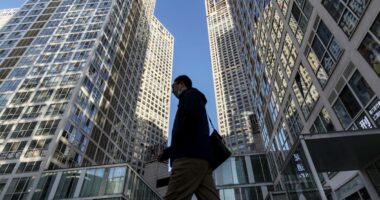
The Hmong Village, a sprawling indoor mall in St. Paul, Minnesota, has long been the center of cultural and commercial life for the Hmong diaspora.
It’s filled with restaurants, street fairs and specialty goods stores that attract visitors across the country, and for the past three Saturdays, it’s also become the site of a mass vaccination effort that’s immunized at least 600 Hmong seniors and health care workers.
The makeshift clinics are part of a new program from the Minnesota Department of Health that seeks to reduce access disparities by supplying shots to pharmacies located in low-income, nonwhite neighborhoods.
Under the initiative, the Phelan Family Pharmacy and the Hmong Medical Association worked together to ramp up vaccinations in Hmong enclaves. Because of language and technology barriers, older community members have struggled to book appointments through the state’s online registration system.
To spread the word about the program and recruit volunteers, the Hmong Medical Association reached out to Hmong churches, nonprofits, ethnic radio stations, adult day care centers and primary care clinics. Roughly 50 doctors, nurses and interpreters run the Saturday clinics, inoculating patients, briefing them on the risks and side effects of the procedure, and scheduling follow-up appointments.
“It involved a whole neighborhood working together,” David Thao, the association’s president, told NBC Asian America. “They see us all the time, they trust us, they feel comfortable.”
In Minnesota, Asian Americans are 5 percent of the population, but only 3 percent are immunized. In Hawaii, Native Hawaiians and Pacific Islanders make up 41 percent of Covid-19 cases but have received less than 9 percent of vaccinations.
The program is one of several that have emerged across the country in recent months to help vulnerable Asian American and Pacific Islander communities get vaccinated.
Nationwide, about 5 percent of Asian Americans have received Covid-19 shots — a rate comparable to their share of total cases and deaths, and of the population, according to new data from the Centers for Disease Control and Prevention. (The vaccination rates for Black and Hispanic people, by contrast, are lower than their share of the population.)
But experts say these numbers obscure inequities among ethnic groups. East Asian Americans, for instance, have vastly different health outcomes from South Asian Americans and Southeast Asian Americans. Demographic disparities also vary by state: in Minnesota, Asian Americans are 5 percent of the population, but only 3 percent are immunized. In Hawaii, Native Hawaiians and Pacific Islanders make up 41 percent of Covid-19 cases but have received less than 9 percent of shots distributed.
“Lumping all Asian Americans into one category hides a lot of the challenges that our communities face,” Hyun Namkoong, a policy advocate at the North Carolina Justice Center, said. “We don’t know who is having a hard time within the Asian American community with regard to getting vaccinated.”
Having disaggregated health data, Namkoong said, would allow social services organizations to conduct even more targeted outreach to Asian American groups that are struggling to get vaccinated.
North Carolina, for example, has a sizable population of Hmong and Burmese refugees, most of whom speak limited English and work low-wage jobs. Some also fear that registering for a vaccination would jeopardize their immigration status.
So the North Carolina Justice Center made flyers in multiple Asian languages, including Chinese, Burmese and Vietnamese, assuring patients that getting vaccinated wouldn’t diminish their chances of obtaining green cards and that the Department of Health wouldn’t share personal information with Immigration and Customs Enforcement.
In Nevada, public health advocates are using ethnic media to explain the science behind the vaccines and dispel misinformation. Marife Aczon-Armstrong, a founding president of the Asian American Pacific Islander Nurses Association of Nevada, hosts a weekly program on PHLV, a local Filipino radio station, in which she spotlights vaccination initiatives, shares relevant updates and interviews prominent immunologists about how each dose affects the immune system.
“There’s some misunderstanding like, ‘If I get vaccinated and get sick, I’ll infect those around me,’” she said, adding that it can be difficult even for immigrants who are fluent in English to understand medical jargons.
Vaccine access is a particularly serious concern for Mississippi’s Vietnamese immigrants and refugees, more than one-third of whom are both language- and computer-illiterate.
In a separate initiative, Aczon-Armstrong said, the AAPI Nurses Association has been recruiting nursing students from Nevada’s Roseman University as volunteer interpreters at vaccination clinics.
Language and technology barriers present access challenges for certain Asian American communities in Southern states, which have fewer resources than more populous states like California and New York.
In Mississppi’s Harrison County, people of Asian descent constitute 3 percent of the population but have received just 1.2 percent of doses distributed. While the data is not broken down by ethnicity, vaccination access is a particularly serious concern for the state’s Vietnamese immigrants and refugees, more than one-third of whom are both language- and computer-illiterate, according to Daniel Le, a Gulf Coast branch manager of the nonprofit Boat People SOS.
“What we find is the most effective way of communicating is through word-of-mouth,” he said, noting that translated flyers and guidelines are of little use to the many elders who can’t read in their mother tongue. (The 2010 census puts Mississippi’s Vietnamese population at roughly 7,000, but Le estimated that the figure now is closer to 10,000.)
Over the past month, Le’s group has been working with the Mississippi Department of Health to coordinate a vaccination drive for Vietnamese people who work in the seafood industry and live in rural areas with limited access to information.
Organizers posted about the event on social media so younger people could share it with their grandparents. Leaders at a Vietnamese church and a Buddhist temple, meanwhile, alerted constituents about the program and helped them schedule appointments. At the Coast Coliseum on Monday afternoon, 300 community members were vaccinated.
Le said at-risk seniors have been eager to sign up for the vaccinations.
“Once they heard that it’s available in the neighborhood,” he said, “we’ve had phone call after phone call all day.”
Source: | This article originally belongs to Nbcnews.com









